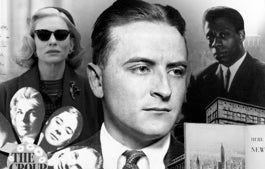

we lived in the Bronx in a one-bedroom apartment with a kitchen in the living room and—this is not a joke—a train station that went right over us. We heard the El at night. It was like Barefoot in the Park. We hung pictures we’d torn from magazines on an inspiration board. We went to get director’s chairs. Orange. Bright. Canvas. We went to the Lower East Side and got antique furs and put them on the bed. We all build our lives, and that’s what we were doing. We were dreaming, dreaming about tomorrow.


It all started with ties, and I called the ties Polo. At the time—this was 1967—I felt there was no tie like the ones I wanted to do. My tie was wide at a time when men wore narrow ties, like today. I searched for unusual fabrics, so they were unique. Men loved them. They bounced off the racks.
I worked in a one-room office in the Empire State Building. I kept all the ties in a drawer, one little drawer. Ricky and her mother and father sewed on the labels, and I sold to the stores. I delivered the orders myself in an old bomber jacket and jeans. I’d hail a cab carrying a bag full of ties, until I was able to buy my own car—a vintage Morgan, in which I made rounds with the top down.



Back then, men of all ages wore ties, but they were used to them being narrow. I thought the world was ready for a change, and I had a vision based on what I wanted to look like and the things I couldn’t find. I’d wanted a wide tie, so I made it. There’d been wide ties before. The innovation was that I was making them from unexpected fabrics—patterns, classic repp stripes, and prints. Then, I needed a shirt made for a wide tie, and I wanted it to have a spread collar.
The stores loved the ties and wanted more. They said, what else can you do? I told them I could do shirts, suits. The lapels on a sport coat and suit also had to be balanced to go with the width of my ties. It was understated, but, still, it was change—and the world was ready for it. Polo became an item. It became the Polo tie, the Polo look. I was beginning to move and change menswear in a simple way. And then I said I think I can do womenswear, children’s clothes, home. Each new thing was an evolution of this one world, which started with the wide tie.
It’s still amazing to me. I was just a kid from the Bronx with a dream about a world I saw in my mind. I made things that I loved, and, as it turned out, other people loved them, too.








